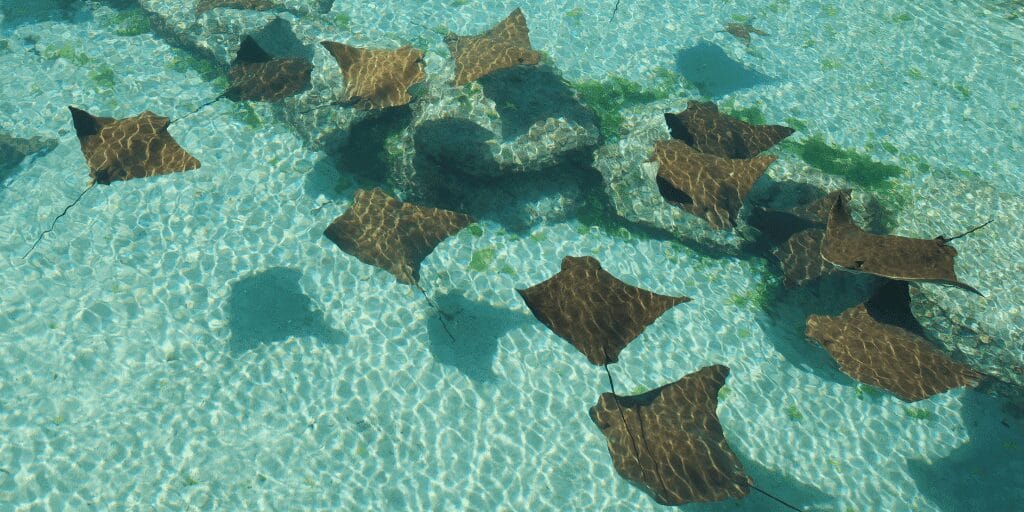Venture into California’s wild side and discover the delicate balance between human safety and the preservation of its most formidable residents. From the stealthy mountain lion to the venomous rattlesnake, this article unveils the essential knowledge and precautions needed to coexist with the Golden State’s dangerous animals.
Key Takeaways:
- California hosts a range of apex predators such as mountain lions and great white sharks, which are generally rare threats to humans if proper precautions are taken, such as avoiding swimming at dawn or dusk and hiking in groups during peak predator activity times.
- The state is home to several venomous species, including rattlesnakes and widow spiders, where awareness of their habitats and prompt medical attention in case of bites can mitigate health risks.
- Coastal and marine hazards include stingrays and jellyfish, which can cause painful injuries; preventive measures like the “stingray shuffle” and rinsing stings with vinegar can reduce the likelihood and severity of injuries.
- Urban wildlife encounters are on the rise due to habitat encroachment, with animals like coyotes and bears adapting to city life; securing food sources and trash can prevent unwanted interactions.
- Lesser-known dangers in California’s natural environment include poison oak, ticks carrying Lyme disease, and aggressive yellowjackets, where knowledge of avoidance and proper response to exposure is essential for safety.
Most Dangerous Animals in California
California hosts dangerous animals like mountain lions, great white sharks, rattlesnakes, black widow spiders, stingrays, and jellyfish, with risks mitigated through awareness and precautions.
| Wildlife Category | Species | Key Characteristics and Behavior | Safety Precautions and Responses |
| Apex Predators | Mountain Lions, Great White Sharks | Mountain lions are elusive, prefer dense underbrush; Great white sharks follow migratory patterns, close to beaches. | Avoid hiking or swimming alone at dawn/dusk. If encountered, make noise, appear larger for lions; swim in groups for sharks. |
| Venomous Creatures | Rattlesnakes, Widow Spiders, Scorpions | Rattlesnakes favor dry areas; Widow spiders prefer undisturbed places; Scorpions are nocturnal. | Stay on trails, watch where you step, seek immediate medical attention if bitten/stung. |
| Marine and Coastal | Stingrays, Jellyfish | Stingrays bury in sand in shallow waters; Jellyfish can sting even when beached. | Do the “stingray shuffle” to avoid stings; use vinegar for jellyfish stings, seek medical help if severe. |
| Urban Wildlife | Coyotes, Bears | Coyotes are adaptable to urban areas; Bears attracted by garbage. | Secure trash, avoid feeding wildlife, make noise to scare away coyotes, do not run from bears. |
| Lesser-Known Hazards | Poison Oak, Ticks, Yellowjackets | Poison oak causes itchy rashes; Ticks can transmit Lyme disease; Yellowjackets aggressive in late summer/fall. | Learn to identify and avoid poison oak; check for ticks; keep food covered outdoors, manage pain if stung. |
1. Apex Predators of California

California’s wilderness and urban fringes are home to a variety of apex predators, creatures that sit at the top of the food chain and play a critical role in maintaining the health and balance of their ecosystems. These animals, while essential, can sometimes pose a risk to humans.
Understanding their behavior, the statistical likelihood of dangerous encounters, and how to coexist safely with these animals is crucial for both our safety and the preservation of these species. The following subsections will delve into the specifics of each predator, offering a blend of scientific insight and practical advice.
Mountain Lions
Mountain lions, also known as cougars or pumas, are among the most elusive and powerful predators in California. They roam vast territories that span from the coastal mountains to the deserts, preferring areas with dense underbrush and plenty of prey, such as deer. Despite their wide range, mountain lion attacks on humans are exceedingly rare. In fact, a person is more likely to be struck by lightning than to be harmed by a mountain lion.
To maintain this low risk, it’s important for hikers and residents in mountain lion territories to be aware of their surroundings. Avoid hiking alone at dawn, dusk, or at night when mountain lions are most active.
If you do encounter one, make yourself appear larger, make noise, and back away slowly—never run. Recent studies from wildlife authorities reinforce that with proper education and preventative measures, negative interactions can be minimized.
Great White Sharks
The waters off California’s coast are a seasonal home to the great white shark, an apex predator that inspires both awe and fear. These sharks follow migratory patterns that often bring them close to popular beaches, especially between April and October. Great whites typically feed on marine mammals like seals and sea lions, and while shark attacks on humans are extremely rare, they do occur.
To put things into perspective, the International Shark Attack File reports that the chances of being attacked by a shark are about 1 in 11.5 million. For those who love the ocean, wearing brightly colored clothing can attract sharks, so it’s recommended to stick to neutral colors.
Always swim in groups, as sharks are more likely to target solitary individuals. Marine biologists also advise against swimming at dawn or dusk when sharks are most active. By following these guidelines, beachgoers can significantly reduce their risk of encountering these formidable yet fascinating creatures.
2. Venomous Creatures of the Golden State
California’s diverse landscapes are home to a variety of venomous creatures that, while small, pose significant threats to humans. Understanding these creatures’ appearances, behaviors, and habitats is crucial for both residents and visitors. Knowledge is power, and being prepared can prevent dangerous encounters with venomous snakes, spiders, and insects.
This section will delve into the identification of these creatures, the potential health risks they present, and the essential first-aid advice for each venomous encounter.
Rattlesnakes
California is home to several species of rattlesnakes, including the Western Diamondback, Mojave, and Sidewinder. These snakes favor dry, rocky areas and are often found in the state’s desert and coastal regions. A telltale sign of a rattlesnake’s presence is the distinctive rattle sound, which serves as a warning.
To avoid bites, stay on well-used trails, watch where you step or reach, and never touch or disturb a snake. If you encounter a rattlesnake, give it space and slowly back away.
In the unfortunate event of a bite, remain calm and immobilize the affected area. Do not attempt to suck out the venom or apply a tourniquet. These outdated methods can do more harm than good. Instead, seek immediate medical attention, as antivenom is most effective when administered early. Remember, rattlesnake bites are a medical emergency.
Scorpions
While scorpions may seem menacing, most species in California are not considered dangerous to humans. However, the Bark Scorpion, which can be found in the southeastern parts of the state, does have a sting that can cause significant discomfort. Scorpions are nocturnal and tend to hide in dark, cool places. To minimize the risk of stings, keep your living spaces clean, reduce clutter, and seal cracks and crevices in your home.
If you are stung by a scorpion, clean the area with soap and water and apply a cool compress to reduce swelling. Pain and swelling are common, but if you experience severe symptoms such as difficulty breathing or muscle twitching, seek medical attention immediately.
Widow Spiders
The Western Black Widow and Brown Widow spiders are two venomous arachnids residing in California. These spiders are identifiable by their shiny black bodies and the red hourglass marking on the underside of the Black Widow. They prefer undisturbed areas like woodpiles, storage boxes, and under furniture. Bites from these spiders can cause muscle pain, nausea, and difficulty breathing.
To treat a bite, wash the area with soap and water and apply a cold compress. Over-the-counter pain relievers can help manage discomfort.
If symptoms are severe or if the victim is very young, elderly, or has a compromised immune system, medical attention should be sought. To reduce encounters, be cautious when moving items stored for long periods and wear gloves during such activities.
Desert Recluse Spider
The Desert Recluse Spider, less common than the Widow spiders, is found in the arid regions of California. It is recognized by its violin-shaped marking on its back. Bites are rare but can cause significant tissue damage. Symptoms include redness, pain, and blistering at the bite site, which may develop into a lesion if left untreated.
First-aid for a Desert Recluse bite includes cleaning the wound and applying a cold compress. Avoid any activity that can increase blood flow to the affected area, such as exercise or consuming caffeine, as this can spread the spider’s venom.
If you suspect a bite from a Desert Recluse, seek medical attention promptly. To prevent bites, shake out clothing and shoes before wearing them and use caution when handling boxes or other items from storage areas.
3. Marine and Coastal Threats

California’s coastline is a stunning expanse of over 800 miles, offering breathtaking views and a rich array of marine life. However, beneath the waves, certain creatures can pose risks to the unwary. Understanding these potential dangers and knowing how to respond to them can help ensure that your time spent by the sea is both enjoyable and safe.
Stingrays
Stingrays are quite common in the shallow coastal waters of California. They often bury themselves in the sand, which can lead to accidental encounters with beachgoers. When threatened, stingrays can deliver a painful sting using the sharp barb on their tail. The injuries typically involve a puncture wound and can be accompanied by severe pain, swelling, and even muscle cramps or nausea.
To avoid an unwelcome sting, the “stingray shuffle” is an effective technique. By shuffling your feet as you walk in shallow water, you create vibrations that warn stingrays of your approach, encouraging them to swim away. Additionally, always be vigilant when entering the water, especially in areas known for stingray presence.
If you do get stung, it’s important to act quickly. Immerse the affected area in hot water, as heat can help neutralize the stingray’s venom and alleviate pain. However, be cautious not to scald the skin. The pain may be intense, and if it persists or if the wound appears severe, it’s crucial to seek medical attention promptly.
Jellyfish
The waters along California’s coast are home to various jellyfish species, some of which can sting humans. These creatures are often translucent and can be difficult to spot. They tend to appear more frequently during certain seasons and in specific areas, such as warmer waters or near the surface when the ocean is calm.
If you encounter a jellyfish, it’s important to recognize them by their gelatinous, umbrella-shaped bodies and trailing tentacles. Avoid touching them, as this can lead to stings that cause red, itchy welts and discomfort.
For first aid, rinse the sting with vinegar to deactivate any remaining stinging cells, then remove any tentacles stuck to the skin using a pair of tweezers. Avoid rubbing the area, as this can cause more venom to be released. Afterward, soaking the sting in hot water can help reduce pain and inflammation.
If you experience severe reactions, such as difficulty breathing or chest pain, it’s essential to seek medical help immediately. Remember, while jellyfish stings are usually not life-threatening, they can cause significant discomfort and sometimes require professional care.
4. Encounters with Urban Wildlife
As cities expand and natural habitats shrink, the line between urban spaces and the wild becomes increasingly blurred. This has led to more frequent encounters between humans and wildlife in California’s bustling cities and suburbs.
Animals like coyotes, deer, and even bears have shown remarkable adaptability, learning to navigate our streets and backyards in search of food and shelter. Understanding these animals, the reasons behind our growing interactions, and how to live alongside them safely is crucial for both our well-being and the preservation of these species.
Coyotes
Coyotes are a common sight in California, from the rural outskirts to the heart of major cities. These clever canines have adapted to urban life, often seen trotting along sidewalks or in parks. While coyotes generally avoid humans, they can pose risks, especially to pets and occasionally to children.
To minimize these risks, it’s important to secure food sources, such as pet food left outside, and ensure trash cans are tightly closed. If you happen to cross paths with a coyote, make yourself appear larger, make loud noises, and do not run away, as this could trigger a chase. Educating the community about coexistence with coyotes is key to preventing conflicts.
Deer
Deer, with their serene presence, can also be a source of danger in urban settings. Vehicle collisions with deer are a significant concern, with numerous accidents reported annually in California. To avoid such incidents, drivers should be extra vigilant during dusk and dawn, particularly in the fall during the mating season.
Urban expansion has encroached upon deer habitats, making wildlife corridors essential to allow safe passage for these animals. Awareness and appropriate urban planning can help mitigate the risks associated with deer in our communities.
Black Bears
Black bears are another species that have been spotted more frequently in California’s urban areas. As their natural habitats are encroached upon by human development, bears may venture into neighborhoods, attracted by the smell of garbage or food left outdoors.
To discourage bear visits, homeowners and campers should employ bear-proofing techniques, such as using bear-resistant trash containers and cleaning up food scraps. In the event of a bear encounter, it’s important to stay calm, speak in a firm voice, and back away slowly—never run or play dead.
The state of California actively works to manage bear populations and promote harmonious coexistence, but it’s up to individuals to practice responsible behaviors that will not attract bears to human dwellings.
5. Lesser-Known Hazards

California’s natural environment is not only breathtaking but also houses a variety of lesser-known hazards that can pose risks to the unwary. From plants that cause irritating rashes to marine animals that can be surprisingly dangerous, it’s important to be informed about these potential dangers.
This section will delve into some of these hazards, providing you with the knowledge to identify them, prevent unpleasant encounters, and handle situations should they arise.
Poison Oak
Poison oak is a plant that’s as common in California’s outdoors as it is irritating. It can be identified by its clusters of three leaflets, which change color with the seasons—from green in spring to red or orange in fall. Brushing against poison oak can lead to contact dermatitis, a condition marked by itchy, blistering rashes.
To avoid this, hikers and outdoor enthusiasts should learn to recognize the plant in various seasons and stay on clear paths. If you do come into contact with poison oak, washing the area with soap and water as soon as possible can reduce the severity of the reaction.
Over-the-counter creams and antihistamines can help manage symptoms, but severe cases may require medical attention.
Sea Lions and Seals

The California coastline is a haven for marine mammals like sea lions and seals. While they may appear cute and docile, it’s important to respect their space and understand that they are wild animals.
Observing from a distance is key; getting too close can lead to aggressive behavior, especially if the animals feel threatened. If you encounter a sea lion or seal that seems aggressive or ill, it’s best to back away slowly and notify local wildlife officials.
Remember, it’s illegal to harass marine mammals, and they are protected under federal law. Rehabilitation centers play a crucial role in caring for those that are injured or sick, ensuring they can return to the wild safely.
Ticks
Ticks in California can carry diseases like Lyme disease, making them a tiny but significant threat. To prevent tick bites, use insect repellent and wear long sleeves and pants when in areas known for ticks. After outdoor activities, perform thorough tick checks on yourself, children, and pets.
If you find a tick, remove it promptly with fine-tipped tweezers, pulling straight out to ensure the entire tick is removed. Keep an eye on the bite site for signs of infection or illness, and consult a doctor if symptoms develop.
Wild Boars
Wild boars are not only a nuisance to ecosystems but can also be dangerous to humans. These animals are best avoided by keeping a safe distance and securing food sources to not attract them.
Feeding wild boars is a bad idea as it encourages them to approach humans, increasing the risk of an encounter. Wildlife management efforts are in place to control the population of wild boars and minimize conflicts with humans.
Yellowjackets
Yellowjackets can become particularly aggressive during late summer and fall. To avoid attracting these stinging insects, keep your picnic and outdoor event areas clean, cover food, and promptly dispose of garbage.
If you are stung by a yellowjacket, applying a cold compress can help reduce pain and swelling. For those with allergies to insect stings, it’s crucial to have an epinephrine auto-injector on hand and seek immediate medical attention if stung.
Tarantula Hawk Wasps
The tarantula hawk wasp, with its large size and powerful sting, can be an intimidating sight. However, these wasps are generally not interested in humans and pose a low risk. They can be identified by their black bodies with bright orange wings. To avoid disturbing them, move calmly and quietly when in their presence.
In the rare case of a sting, pain management is the primary concern, as the sting is not typically dangerous. Remember, these wasps play an important role in the ecosystem by controlling tarantula populations.
Conclusion
In conclusion, California’s diverse ecosystems host a range of dangerous animals, from apex predators like mountain lions and great white sharks to venomous creatures such as rattlesnakes and widow spiders. While encounters with these animals can be alarming, they are generally rare and can often be avoided through awareness and precautionary measures.
The state’s marine life and urban wildlife also present their own challenges, but with education on behavior and habitat, risks can be minimized. Lesser-known hazards like poison oak, ticks, and aggressive insects require vigilance and proper response to ensure safety.
By respecting wildlife, understanding the potential dangers, and taking appropriate actions, Californians and visitors alike can coexist with the native fauna and enjoy the natural beauty of the Golden State without undue fear.








